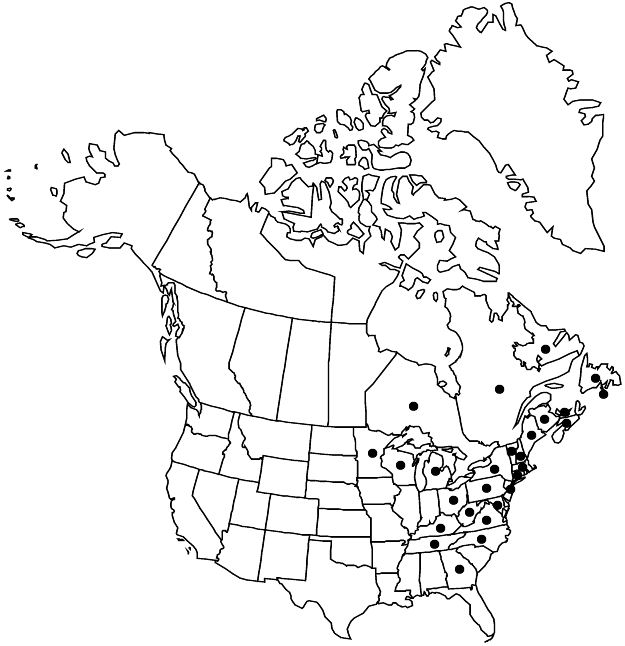Oxalis montana
Amer. Monthly Mag. & Crit. Rev. 2: 266. 1818.
Herbs perennial, acaulous, caudex present, branched, scaly, rhizomes present, fleshy-thickened, densely scaly, stolons absent, bulbs absent. Leaves basal; petiole (2.5–)3–9 cm, villous, hairs reddish; leaflets 3, green, broadly obcordate, 10–16(–20) mm, lobed 1/5 length, lobes apically convex, surfaces glabrous, oxalate deposits absent. Inflorescences 1-flowered; scapes 4–15 cm, glabrous or sparsely villous, hairs reddish. Flowers heterostylous; sepal apices without tubercles; petals white with orange-yellow spot sub-basally, rose colored band proximally, and prominent rose colored veins, 10–15 mm. Capsules subglobose, 2–4 mm, glabrous. 2n = 22.
Phenology: Flowering May–Aug.
Habitat: Spruce-fir, spruce-hemlock, spruce-cedar, spruce-birch, mixed conifer-hardwoods, beech-maple, damp and swampy woods.
Elevation: 100–2200 m.
Distribution

St. Pierre and Miquelon, N.B., Nfld. and Labr., N.S., Ont., P.E.I., Que., Conn., Ga., Ky., Maine, Md., Mass., Mich., Minn., N.H., N.J., N.Y., N.C., Ohio, Pa., Tenn., Vt., Va., W.Va., Wis.
Discussion
Oxalis montana of eastern North America and O. oregana of the Pacific region have sometimes been treated as disjunct geographical taxa of the European (or Eurasian, depending on taxonomic interpretation) O. acetosella Linnaeus. The three are very similar and surely are closely related. Section Acetosellae Reiche also includes the Asian O. griffithii Edgeworth & Hooker f., O. leucolepsis Diels, and O. obtriangulata Maximowicz, as well as O. magellanica G. Forster (South America, New Zealand, Tasmania); the first two of these also have been treated as taxa within O. acetosella (see synonyms in Liu Q. R. and M. F. Watson 2008). Among all these, typical O. acetosella, the two American taxa, and O. magellanica have erect flowers, while those of the strictly Asian taxa are distinctly nodding, perhaps suggesting that the latter are monophyletic.
Oxalis oregana stands apart from O. montana and typical O. acetosella in its larger leaves and flowers and its strigose-villous (versus glabrous) sepals. Each of the three is distinct in petal coloration and this difference between O. acetosella and O. montana is perhaps the only one between them besides the geographical disjunction. In O. montana, the orange-yellow region near the petal base is constricted to a spot (versus a lateral band in typical O. acetosella) and a light and diffuse but distinct rose colored band lies immediately distal to the spot, connecting among the petals to form a circle. Oxalis acetosella in the strict sense occurs from Iceland to southern Europe (and possibly northern Africa), reportedly stretching as a broad band completely across Eurasia to Japan to Korea (J. F. Veldkamp 1971; Liu Q. R. and M. F. Watson 2008). Attributions of O. acetosella to Pakistan and other Himalayan localities apparently are based on plants of O. griffithii.